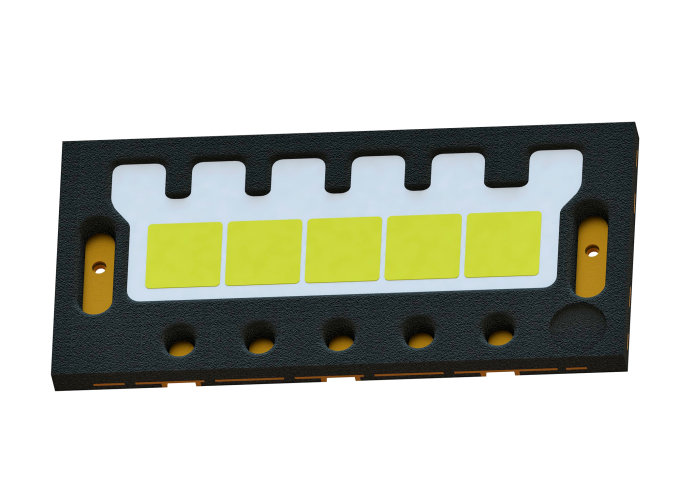A powerful performer: Oslon Black Flat S provides up to 2000 lumen

Osram Opto Semiconductors presents its automotive LED prototype at ISAL 2015
Osram Opto Semiconductors is unveiling an LED prototype in surface mount technology (SMT) with a brightness of up to 2000 lumen (lm) at ISAL 2015 – the Oslon Black Flat S. Experts achieved this high output by combining five chips from the latest UX:3 generation with an improved SMT package. A single LED is therefore sufficient as the light source for combined low-beam and high-beam systems. The excellent thermal connection with the package allows for passive cooling, which reduces system costs. The Oslon Black Flat S is consequently a viable alternative to HID (High Intensity Discharge) lamps and is scheduled to be added to the Osram automotive portfolio at the end of 2016.

Osram Opto Semiconductors is showcasing the new SMT prototype Oslon Black Flat S with five high-current chips at ISAL 2015 (International Symposium on Automotive Lighting). In terms of increasing output, this is a logical development of existing versions of the automotive product family and shows that high luminous flux values of up to 2000 lumen (lm) are possible from a single light emitting diode (LED). At the same time, the SMT component has a footprint of 3.75 mm x 7.9 mm, which is only slightly larger than that of the previous 5-chip version.
Improved heat distribution – essential in view of the high currents involved – provides the basis for the high brightness. This brightness comes from five high-current chips based on latest-generation UX:3 technology, together with an improved package. The thermal connection has been greatly improved by larger contact pads, which means that the headlights can benefit from passive cooling. This in turn reduces system costs considerably and makes the LED solution a viable alternative for vehicles that are now equipped with HID lamps. At a current of 1 ampere (A), a power loss of 12 watt (W) and an ambient temperature of 25°C, the temperature at the chip is only 69°C, which means that the temperature difference compared with the predecessor version has been reduced from 58°C to 44°C. The prototype LED is operated at a current of 2 A and a voltage of 15.5 V. The optical output is 6.5 W.
“The five chips of the Oslon Black Flat S can also be driven individually”, said Stefan Grötsch, Senior Key Expert Automotive Application Engineering at Osram Opto Semiconductors. “The future LED version will therefore be ideal for adaptive front lighting systems.”
ABOUT OSRAM
OSRAM of Munich, Germany is one of the two leading light manufacturers in the world. The company's portfolio covers the entire value chain from components – including lamps, electronic control gear and opto semiconductors such as light-emitting diodes (LED) – as well as luminaires, light management systems and lighting solutions. OSRAM has around 34,000 employees worldwide and generated revenue of more than €5.1 billion in fiscal 2014 (ended September 30). The company's business activities have been focusing on light – and hence on quality of life – for over 100 years. The company was listed on the stock exchanges in Frankfurt and Munich on July 8, 2013 (ISIN: DE000LED4000; WKN: LED 400; Trading symbol: OSR).
Additional information can be found at www.osram-group.com
DISCLAIMER
This document contains statements and information pertaining to our future business and financial performance and future developments that may constitute forward-looking statements – i.e. statements about processes that take place in the future, not in the past. These statements pertaining to the future can be identified by expressions such as "anticipate", "expect", "want", "intend", "plan", "believe", "aspire", "estimate", "will”, "predict" or words of similar meaning. Such statements are based on current expectations and certain assumptions of OSRAM‟s management. They are, therefore, subject to certain risks and uncertainties. A variety of factors, many of which are beyond OSRAM‟s control, affect OSRAM‟s operations, performance, business strategy and results and could cause the actual results, performance or achievements of OSRAM to be material different from any future results, performance or achievements that may be expressed or implied by such forward-looking statements or anticipated on the basis of historic trends. These factors include in particular, but are not limited to the matters described in the chapter “Report on Risks and Opportunities” in the Annual Report of OSRAM Licht Group. Should one or more of these risks or uncertainties materialize, or should underlying assumptions prove incorrect, actual results, performance or achievements of OSRAM may vary materially from those described in the relevant forward-looking statement as being expected, anticipated, intended, planned, believed, sought, estimated or projected. OSRAM neither intends, nor assumes any obligation, to update or revise these forward-looking statements in light of developments which differ from those anticipated. Due to rounding, numbers presented throughout this and other documents may not add up precisely to the totals provided and percentages may not precisely reflect the absolute figures they reference.